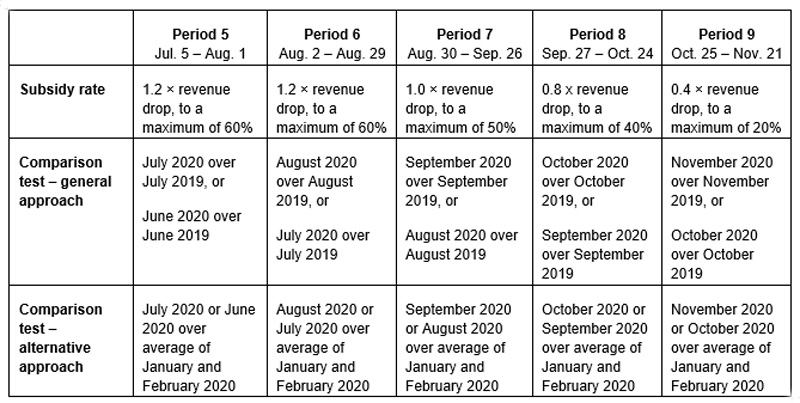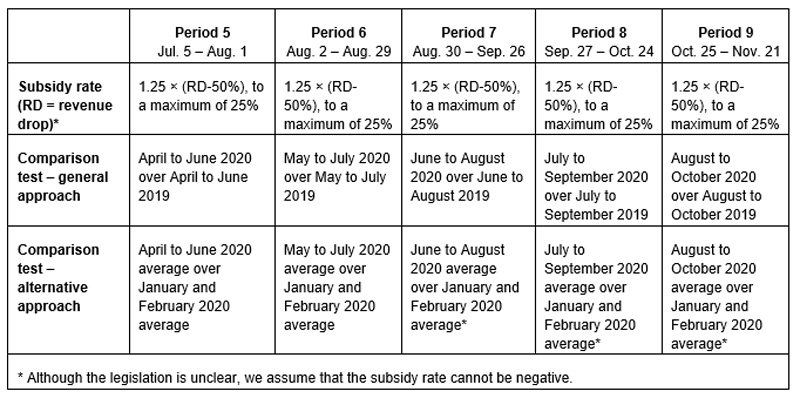
CEWS program revised and extended: Details announced
The changes to the CEWS received first reading in the House of Commons as Bill C-20 on July 20, 2020. At the time of writing, the bill had not received Royal Assent, but we expect it will become law.
Some of the measures were previously tabled in Bill C-17.
Note, however, the new details only apply up to the period ending on November 21, 2020. We expect the government will release more details later about the CEWS’ final four weeks.
Some issues that we raised with the government and are addressed by the new rules include the following:
- The CEWS should give more support to employers who need it the most. The original program offered the same support to all employers who saw their revenues decline by 30 per cent or more, no matter how steep the actual decline.
- The CEWS should be phased out gradually, in terms of both the revenue test for specific employers and more generally. Some employers were concerned that rising revenues could push them under the 30 per cent threshold, causing them to lose their entire benefit all at once and before they regained the economic activity and cash flow they need to keep their workers employed and businesses operating.
- The rules adversely affected many employers who recently acquired another business, as the added revenue from the acquired assets often made it difficult to meet the 30 per cent test.
We had also suggested that simplifying the program would also help employers. The latest changes simplify a few concepts, but employers also have to deal with some complex new formulas and calculations.
We note that the backgrounder from the Department of Finance Canada provides more commentary on the revised rules and examples that show how they work. We recommend reading the backgrounder in detail together with this blog post.
In this post, we’ll refer to the rules that apply to periods 1 to 4 as the “original rules” and those for periods 5 to 9 as the “new rules.” Under a safe harbour provision, employers can apply the original rules to periods 5 and 6, rather than the new rules, if this increases their subsidy. So, both sets of rules run in parallel for periods 5 and 6.
How do the new rules work?
The new rules have two different CEWS rate structures – one calculated based on remuneration paid to active employees and the second for employees that are furloughed (i.e., on leave).
The subsidy rate for active employees is based on a two-part calculation that determines:
- a base subsidy rate designed to apply to most employers who have seen a business decline, plus
- a top-up subsidy rate for employers affected more severely
The total subsidy rate is then applied to eligible weekly remuneration. The eligible remuneration amount for each arm’s length employee is the amount paid in respect of the week, up to a weekly maximum of $1,129 per employee. For arm’s length employees, baseline remuneration is no longer part of the calculation, but it remains relevant for non-arm’s length employees.
The overall CEWS subsidy for each week for active employees therefore equals the base CEWS rate plus the top-up CEWS rate times the total eligible remuneration.
We discuss the rate structure for furloughed employees later in this post.
How is the base subsidy rate calculated?
For period 5 and later periods, employers with a revenue decline — even of less than 30 per cent — will be eligible for a base CEWS rate for active employees. The rate depends on the actual decline in revenue – the higher the decline, the higher the rate. Where the decline is 50 per cent or more, the base rate is capped at 60 per cent for periods 5 and 6. This cap drops further for periods 7, 8 and 9.
Like the original rules, employers can compare their current revenue to:
- their revenue in same month in 2019 (“general approach”), or
- their average monthly revenue for January and February 2020 (“alternative approach”)
For this test, employers can use revenue for either the current or prior month, so they can automatically qualify for the following period using the same revenue reduction when this is to their benefit.
The comparison test chosen for period 5 claims must then be used for the balance of the program for calculating both the base and top-up CEWS rates (as we discuss later). The choice made for periods 1 to 4 under the original rules does not affect the decision for period 5.
The chart below sets out the rate formula and comparison periods for periods 5 to 9.

For example, if the revenue drop in period 5 using either the general approach or the alternative approach is 40 per cent, the base subsidy rate is 48 per cent (1.2 × 40%).
How is the top-up subsidy rate calculated?
The top-up portion of the subsidy aims to help employers whose revenue has dropped by 50 per cent or more. Similar to the base subsidy, the top-up rate varies based on the size of the revenue drop and is subject to a cap of 25 per cent. This cap applies if the three-month average revenue drop is 70 per cent or more. However, unlike the base subsidy, the rate and cap amounts do not decline over time.
The revenue drop is determined under the general approach by comparing revenues in the preceding three months to the same months in the prior year. Under the alternative approach, the drop is determined by comparing average monthly revenue in the preceding three months to the average monthly revenue in January and February 2020.
The rate formula and the specific comparison periods are set out in the chart below:

For example, where the revenue decline is 60 per cent, the subsidy rate is 12.5 per cent [1.25 × (60% - 50%)]
How will the subsidy apply for furloughed employees?
The new rules set a separate calculation for employees who have been “furloughed.” For period 5 and later periods, the CEWS for furloughed employees will be available to eligible employers who qualify for the base or top-up rate for active employees in the relevant period.
The subsidy amount for furloughed employees depends on the claim period:
- For periods 5 and 6, the subsidy is the same as for periods 1 to 4, that is, the greater of:
- for arm’s-length employees, 75 per cent of the amount of remuneration paid, to a maximum benefit of $847 per week; and
- 75 per cent of the employee’s pre-crisis weekly remuneration, to a maximum benefit of $847 per week or the amount of remuneration paid, whichever is less.
- Beginning in period 7, CEWS support for furloughed employees will be adjusted to align with the benefits provided through the Canada Emergency Response Benefit (CERB) and/or Employment Insurance (EI).
For period 7 and beyond, the exact amount of the subsidy is unclear as the legislation refers to a regulated amount. We’ll keep you posted as details become available.
Also, the employer portion of contributions for furloughed employees to the Canada Pension Plan, EI, Quebec Pension Plan and Quebec Parental Insurance Plan will continue to be refunded to the employer.
Other CEWS changes
Along with the new formulas and calculations, employers and their advisers need to consider some other important changes to the program, including these amendments:
Eligible employee definition modified
Starting in period 5, an employee no longer has to be paid for 14 consecutive days to meet the definition of an eligible employee.
Deadline to submit claims extended
Qualifying entities can still apply for the CEWS retroactively, as long as their applications are received before February 2021 (instead of the previous September 30, 2020 deadline).
Relief for asset purchases
Many stakeholders raised the concern under the original rules that it is more difficult to meet the 30 per cent revenue test when an asset was purchased between the current period and the comparison period. Continuity rules are now provided for calculating an acquirer’s drop in revenues. These rules are subject to conditions, which include:
- the seller used the acquired assets to carry on a business in Canada
- the buyer purchased all or substantially all of the seller’s assets used to carry on business in Canada (based on market value and including all businesses)
- the buyer and seller made a joint election in prescribed manner and form with the Canada Revenue Agency (CRA) (unless the seller no longer exists, in which case the buyer makes the election)
Where the conditions are met, the revenue from the acquired assets in both the past or current reference period is included in the buyer’s revenue for the qualifying period and excluded from the seller’s (which is why a joint election is needed if the seller still exists).
Entities using the cash method of accounting can elect to use the accrual method for CEWS
Under the new rules, entities that use the cash method of accounting can elect to use the accrual method for the CEWS. Once this election is made, it must be applied to all qualifying periods. This change applies to all periods.
Formal appeals process now in place
The rules will provide for an appeal process based on the existing procedure for notices of determination that allows for an appeal to the Tax Court of Canada.
Baseline remuneration periods expanded
In addition to the original baseline remuneration period of January 1 to March 15, 2020, Bill C-17 proposed to add an alternative baseline period that begins on March 1, 2019 and ends on May 31, 2019.
Bill C-20 adds two more alternative baseline periods:
- one alternative period begins March 1, 2019 and ends June 30, 2019
- the second begins July 1, 2019 and ends December 31, 2019
Related Bill C-17 proposals are now incorporated into Bill C-20
As noted, several changes first announced in Bill C-17 are now included in Bill C-20. These measures include:
- changes to align the definition of eligible entity with the treatment of tax-exempt trusts and corporations
- changes to extend the definition of qualifying entity to otherwise eligible employers who use paymaster arrangements (and typically do not have CRA payroll accounts)
- changes to allow corporations formed by amalgamations to calculate their benchmark revenue using combined revenues
Some final observations
Overall, we believe these latest changes will help in easing concerns raised by our members and other stakeholders, although some issues remain. Key takeaways for employers and their advisers are as follows:
- We welcome the change toward graduated assistance, but the rules are more complicated than we expected. We encourage the CRA to provide tools to help with the calculations.
- The accuracy of monthly revenue calculations will be more important under the new rules for some employers as the specific decline in revenue will directly impact the CEWS subsidy rate. Under the original rules, it may have been clear that the revenue reduction was far in excess of 30 per cent. Similar, the importance of good documentation has increased.
- Given the safe harbour rule for periods 5 and 6, employers should apply both the original rules and the new rules to see which approach produces the best results.
- In period 5, employers must decide whether the general approach or the alternative approach gives better results for revenue comparisons.
- For the new base subsidy and top-up subsidy, baseline remuneration is no longer relevant for active arm’s-length employees. Both subsidy amounts will be based on the amount paid for that week, to a maximum of $1,129. Baseline remuneration will continue to be relevant for non-arm’s length employees.
- For furloughed employees, more information is needed on how the program will operate after period 6.
We will continue to work with the CRA on improving the CEWS application process and developing tools to help employers make their claims. We’ll also continue to update you regularly on the CEWS and other COVID-19 emergency relief measures as things develop.
NOTE: The commentary function of this page has been temporarily closed. Unfortunately, because of the volume of feedback regarding recently announced COVID-19 tax measures, we do not have the capacity to respond to individual inquiries. We strongly encourage you to visit our Federal Government COVID-19 Tax Updates page for information.